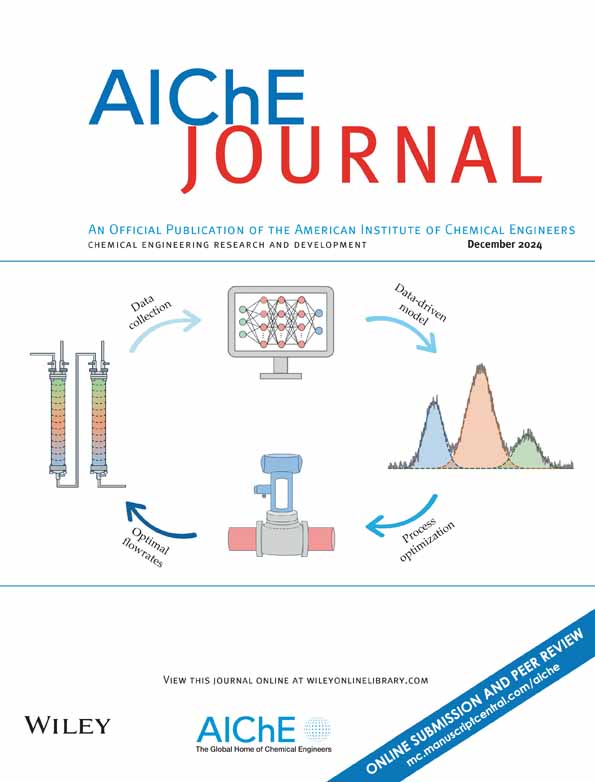Bi2MoO6单层中亚表面Ce掺杂物作为光催化C-N偶联反应的促进剂
IF 3.5
3区 工程技术
Q2 ENGINEERING, CHEMICAL
引用次数: 0
摘要
虽然掺杂一直是提高光催化性能的通用策略之一,但了解亚表面掺杂物在光催化中的作用仍然具有很大的挑战性。本文制备了掺杂ce的Bi2MoO6单层膜,用于光催化C-N偶联反应。通过一系列表征和密度泛函理论计算,深入研究了表面下Ce掺杂对光催化的影响。特别是,亚表面Ce有利于光生电子的迁移,增强了对硝基苯的吸附。ce诱导的氧空位促进了Lewis酸碱对(Mo/O)的形成,有利于苯甲醇的吸附。它为载体到反应物的转移建立了有效的途径。因此,典型的Ce (0.04 mmol)掺杂Bi2MoO6的硝基苯转化率为94.5%,仲胺选择性为99.1%。本文重点研究了亚表面掺杂剂在光催化中的作用,为高效光催化剂的设计和结构-功能关系的研究提供了新的思路。本文章由计算机程序翻译,如有差异,请以英文原文为准。
Subsurface Ce dopants in Bi2MoO6 monolayers as promoters for photocatalytic C-N coupling reaction
Understanding the role of subsurface dopants in photocatalysis is still highly challenging, although doping has always been one of the universal strategies for improving photocatalytic performance. Herein, Ce-doped Bi2MoO6 monolayers were prepared for the photocatalytic C–N coupling reaction. Effects of subsurface Ce dopants on photocatalysis were investigated deeply via a series of characterizations and density functional theory calculations. Especially, subsurface Ce facilitates the migration of photogenerated electrons and enhances the adsorption of nitrobenzene. Ce-induced oxygen vacancies promote the formation of more frustrated Lewis acid–base pairs (Mo/O), facilitating the adsorption of benzyl alcohol. It establishes efficient pathways for the transfer of carriers to the reactants. Thus, the typical Ce (0.04 mmol)-doped Bi2MoO6 exhibited a nitrobenzene conversion of 94.5% and a secondary amine selectivity of 99.1%. This work focuses on the role of subsurface dopants in photocatalysis, providing new insights for the design of high-efficiency photocatalysts and the investigation of structure–function relationships.
求助全文
通过发布文献求助,成功后即可免费获取论文全文。
去求助
来源期刊

AIChE Journal
工程技术-工程:化工
CiteScore
7.10
自引率
10.80%
发文量
411
审稿时长
3.6 months
期刊介绍:
The AIChE Journal is the premier research monthly in chemical engineering and related fields. This peer-reviewed and broad-based journal reports on the most important and latest technological advances in core areas of chemical engineering as well as in other relevant engineering disciplines. To keep abreast with the progressive outlook of the profession, the Journal has been expanding the scope of its editorial contents to include such fast developing areas as biotechnology, electrochemical engineering, and environmental engineering.
The AIChE Journal is indeed the global communications vehicle for the world-renowned researchers to exchange top-notch research findings with one another. Subscribing to the AIChE Journal is like having immediate access to nine topical journals in the field.
Articles are categorized according to the following topical areas:
Biomolecular Engineering, Bioengineering, Biochemicals, Biofuels, and Food
Inorganic Materials: Synthesis and Processing
Particle Technology and Fluidization
Process Systems Engineering
Reaction Engineering, Kinetics and Catalysis
Separations: Materials, Devices and Processes
Soft Materials: Synthesis, Processing and Products
Thermodynamics and Molecular-Scale Phenomena
Transport Phenomena and Fluid Mechanics.
 求助内容:
求助内容: 应助结果提醒方式:
应助结果提醒方式:


